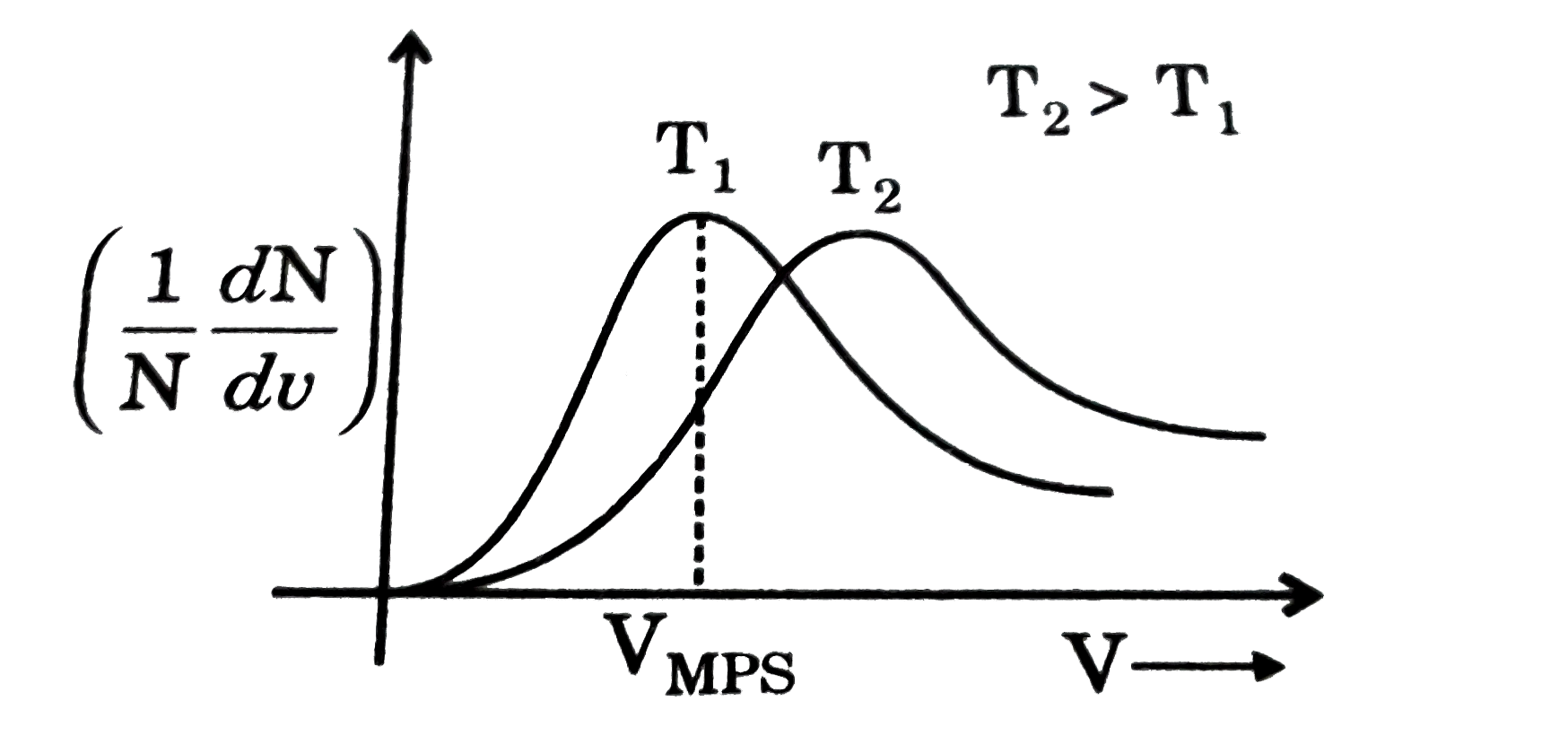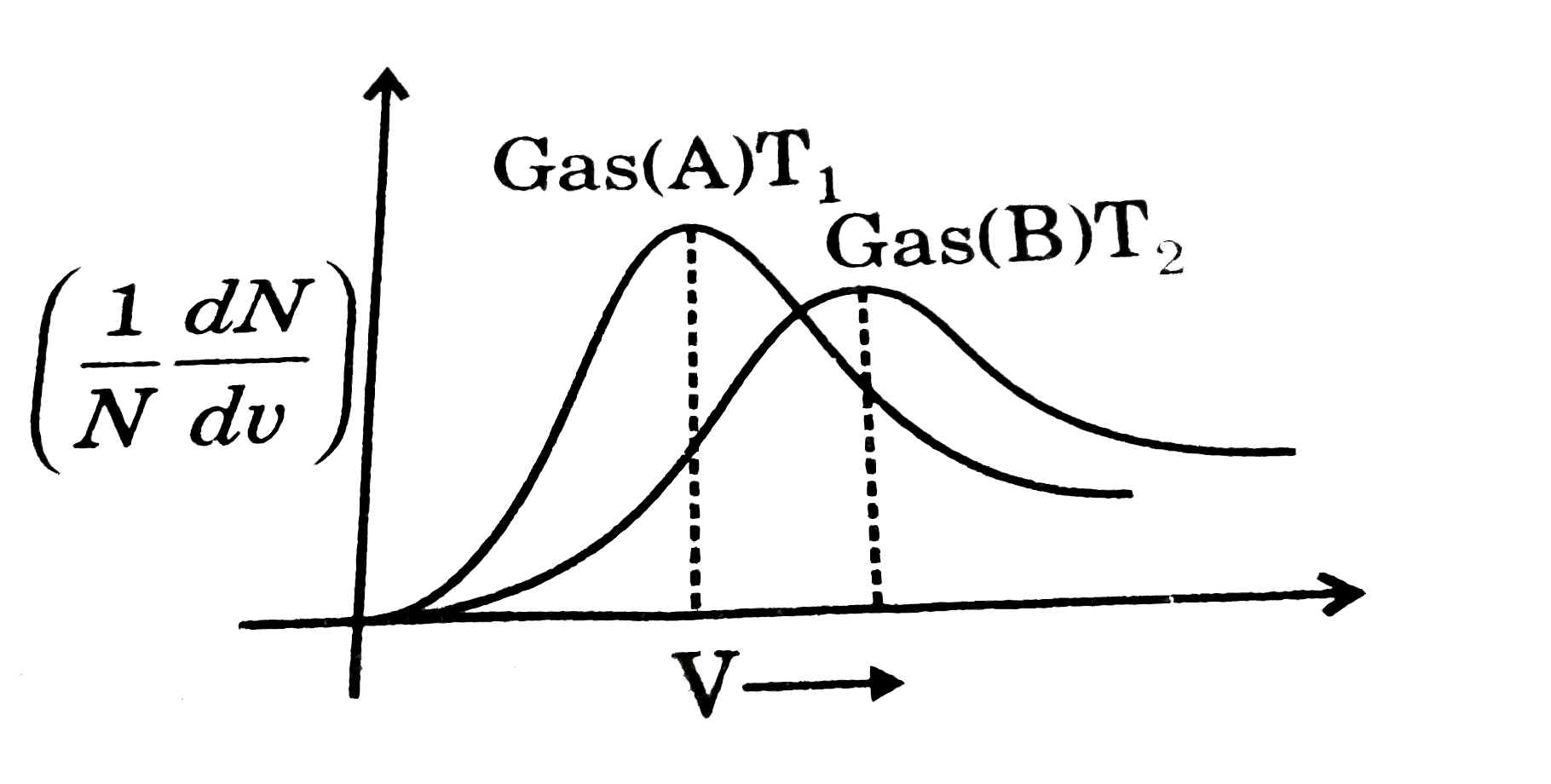The speed of a molecule of a gas changes continuously as a result of collisions with other molecules and with the walls of the container. The speeds of individual molecules therefore change with time.
A direct consequence of the distribution of speeds is that the average kinetric energy is constant for a given temperature.
The average K.E. is defined as
¯¯¯¯¯¯KE=1N(12mΣidNiu21)=12m(ΣidNiN.u21)
where dNN is the fraction of molecules having speeds between ui and ui+du and as proposed by maxwell dNN=4π(m2πKT)3/2exp(−mu22KT).u2.du
The plot of (1NdNdu) is plotted for a particular gas at two different temperature against u as shown.
The majority of molecules have speeds which cluster around vMPS in the middle of the range of v. There area under the curve between any two speeds V1andV2 is the fraction of molecules having speeds betweenV1andV2.
The speed distribution also depends on the mass of the molecules. As the area under the curve is the same (equal to unity) for all gas samples, samples which have the same VMPS will have identical Maxwellian plots. On the basis of the above passage answer the questions that follow.


For the above graph, drawn for two different samples of gases at two different temperature T1andT2. Which of the following statements is necessarily true?
IfT2<T1,MAis necessarily greater thanMB
IfT1>T2,MBis necessarily greater thanMA
T2MB<T1MA
Nothing can be predicted
The correct Answer is:A
Step by step video, text & image solution for The speed of a molecule of a gas changes continuously as a result of collisions with other molecules and with the walls of the container. The speeds of individual molecules therefore change with time. A direct consequence of the distribution of speeds is that the average kinetric energy is constant for a given temperature. The average K.E. is defined as bar(KE) =1/N((1)/(2)m underset(i)SigmadN_(i)u_(1)^(2)) = 1/2 m(underset(i)Sigma(dN_(i))/(N).u_(1)^(2)) where (dN)/(N) is the fraction of molecules having speeds between u_(i) and u_(i) + du and as proposed by maxwell (dN)/(N) = 4pi ((m)/(2pi KT))^(3//2) exp (-("mu"^(2))/(2KT)).u^(2).du The plot of ((1)/(N) (dN)/(du)) is plotted for a particular gas at two different temperature against u as shown. The majority of molecules have speeds which cluster around "v"_("MPS") in the middle of the range of v. There area under the curve between any two speeds V_(1) "and" V_(2) is the fraction of molecules having speeds betweenV_(1) "and" V_(2). The speed distribution also depends on the mass of the molecules. As the area under the curve is the same (equal to unity) for all gas samples, samples which have the same "V"_("MPS") will have identical Maxwellian plots. On the basis of the above passage answer the questions that follow. For the above graph, drawn for two different samples of gases at two different temperature T_(1) "and" T_(2). Which of the following statements is necessarily true? by Chemistry experts to help you in doubts & scoring excellent marks in Class 12 exams.
Updated on:21/07/2023Topper's Solved these Questions
- GRAPHICAL INTERPRETATIONBook:GRB PUBLICATIONChapter:GRAPHICAL INTERPRETATIONExercise:Comprehension 2
Explore 1 Video
- GRAPHICAL INTERPRETATIONBook:GRB PUBLICATIONChapter:GRAPHICAL INTERPRETATIONExercise:Comprehension 3
Explore 1 Video
- GRAPHICAL INTERPRETATIONBook:GRB PUBLICATIONChapter:GRAPHICAL INTERPRETATIONExercise:Comprehension 1
Explore 1 Video
- F-BLOCK ELEMENTSBook:GRB PUBLICATIONChapter:F-BLOCK ELEMENTSExercise:Subjective type
Explore 7 Videos
- HYDROCARBON (ALIPHATIC)Book:GRB PUBLICATIONChapter:HYDROCARBON (ALIPHATIC)Exercise:Previous years jee questions
Explore 28 Videos
Similar Questions
One mole of an ideal gas undergoes a process (10L, 4atm) to (4L, 10 atm ). The process may be represented by straight line in P-V diagram
The correct statement for the process :
View SolutionIn order to perdict variation of Gibbs free energy with progress of reaction at constant temperature and 1 bar pressure, it is important to know realtive stability of the components involved in chemical reaction at standard useful work then the change in Gibbs free energy should be calculated
Which of the following options correctly represects the graph between Gibbs free energy (G0 and state of reaction (SOR) at 1 bar and 300 K for the reaction But -1 ene (A) ⇔ but -2 ene (B)
View SolutionEvery reaction whether started by taking only reactants or by taking only products or any other combination always has a tendency to move towards equilibrium. Hence, equilibrium state can be considered as the one with most stable composition. In case of isomers, based on stability data position of equilibrium can als be decided.
Which of the following options correctly represent ΔG∘f of cis but-2-ene, trans but-2-ene and but-1-ene in kJ/mole?
View SolutionThe first f-block organometallic compound [ThH(OR)(C5Me5)2] was prepared in late 1970s. Find the oxidation state of central metal atom/cation.
View SolutionWhich of the following will decolourise alkaline KMnO4?
View SolutionDistinguish between average speed and rms speed. If three molecules have speed u_(1), u_(2), u_(3) what will be their average speed and rms speed.
View SolutionThe average speed of an ideal gas molecule at 27^(@)C is 0.3 m, sec^(-1) . The average speed at 927^(@)C
View SolutionIn the previous problem , sphere A is moving with speed u_(1) and sphere B with speed u_(2) in opposite direction. After the collision , sphere A comes to rest , then u_(1)//u_(2) is
View SolutionExpress the average kinetic energy per mole of monostomic gas of molar mass M. at temperature T K in terms of the average speed of the molecules U_("avg") .
View SolutionThe speed of a molecule of a gas changes continuously as a result of collisions with other molecules and with the walls of the container. The speeds of individual molecules therefore change with time. A direct consequence of the distribution of speeds is that the average kinetric energy is constant for a given temperature. The average K.E. is defined as bar(KE) =1/N((1)/(2)m underset(i)SigmadN_(i)u_(1)^(2)) = 1/2 m(underset(i)Sigma(dN_(i))/(N).u_(1)^(2)) where (dN)/(N) is the fraction of molecules having speeds between u_(i) and u_(i) + du and as proposed by maxwell (dN)/(N) = 4pi ((m)/(2pi KT))^(3//2) exp (-("mu"^(2))/(2KT)).u^(2).du The plot of ((1)/(N) (dN)/(du)) is plotted for a particular gas at two different temperature against u as shown. The majority of molecules have speeds which cluster around "v"_("MPS") in the middle of the range of v. There area under the curve between any two speeds V_(1) "and" V_(2) is the fraction of molecules having speeds between V_(1) "and" V_(2). The speed distribution also depends on the mass of the molecules. As the area under the curve is the same (equal to unity) for all gas samples, samples which have the same "V"_("MPS") will have identical Maxwellian plots. On the basis of the above passage answer the questions that follow. If a gas sample contains a total of N molecules. The area under any given maxwellian plot is equal ot :
View SolutionThe speed of a molecule of a gas changes continuously as a result of collisions with other molecules and with the walls of the container. The speeds of individual molecules therefore change with time. A direct consequence of the distribution of speeds is that the average kinetric energy is constant for a given temperature. The average K.E. is defined as bar(KE) =1/N((1)/(2)m underset(i)SigmadN_(i)u_(1)^(2)) = 1/2 m(underset(i)Sigma(dN_(i))/(N).u_(1)^(2)) where (dN)/(N) is the fraction of molecules having speeds between u_(i) and u_(i) + du and as proposed by maxwell (dN)/(N) = 4pi ((m)/(2pi KT))^(3//2) exp (-("mu"^(2))/(2KT)).u^(2).du The plot of ((1)/(N) (dN)/(du)) is plotted for a particular gas at two different temperature against u as shown. The majority of molecules have speeds which cluster around "v"_("MPS") in the middle of the range of v. There area under the curve between any two speeds V_(1) "and" V_(2) is the fraction of molecules having speeds between V_(1) "and" V_(2). The speed distribution also depends on the mass of the molecules. As the area under the curve is the same (equal to unity) for all gas samples, samples which have the same "V"_("MPS") will have identical Maxwellian plots. On the basis of the above passage answer the questions that follow. If two gases A and B and at temperature T_(A) "and"T_(B) respectivley have identical Maxwellian plots then which of the following statement are true?
View SolutionAt 27^(@)C a gas contains 10 molecules travelling with a speed of 4 ms^(-1) , 20 molecules travelling with a speed of 5 m s^(-1) and 40 molecules travelling with a speed of 8 m s^(-1) . Calculate the average speed, root mean square speed and most probable speed of the gas at 27^(@)C .
View SolutionIf u_(1), u_(2), u (3) "…..." represent the speed of n_(1), n_(2) , n_(3) ,"…..." molecules , then the root mean square speed is "____________" .
View SolutionThe function un takes on the following values :
u1=14,u2=14+110….....
un=13+1+132+1+….........13n+1….........
Prove that limn→∞ua<12
View SolutionThe function un attains the values
u1=12,u2=12+12.4+12.4.6
un=12+12.4+....12.4....(2n),............
Prove that limn→∞un<2
View Solution